
Jun 6, 2019
“European Obesity Day celebrated every May, brings people together to raise awareness and increase knowledge about obesity and the many other diseases on which it impacts. The aim is to get coordinated action to improve the prevention and treatment of obesity and ultimately to improve the health and quality of life of those who are living with it. The causes of obesity and overweight are known whereby there is an energy imbalance between calories consumed and calories expended. This is being fueled by an increased intake of energy-dense foods that are high in fat, sugar and salt and an increase in physical inactivity due to the increasingly sedentary nature of many forms of work, changing modes of transportation, and increasing urbanisation. Obesity is a disease often caused by factors largely beyond an individual’s control. It is a highly complex matter whereby changes in dietary and physical activity patterns are often the result of environmental and societal changes associated with development and lack of supportive policies in sectors such as health, agriculture, transport, urban planning, environment, food processing, distribution, marketing and education” said Dr Charmaine Gauci, Superintendent of Public Health, Ministry for Health, Malta.
In the meantime, SAFE is focused on what we could do as individuals to tackle this problem and reduce chances of getting a stroke. In Europe, 51.6% of adults are overweight. Being obese not only increases your risk of high blood pressure, heart disease and diabetes, but also makes you more likely to have a stroke, particularly if you are carrying extra weight around your stomach. Fortunately, this is yet another risk factor that can be potentially altered through a healthy diet, exercise and other lifestyle changes.
The relationship between abdominal obesity and stroke is long established, particularly where other conditions are also present, such as diabetes, high blood pressure and high cholesterol. But there are different opinions as to why the risk is increased in overweight people.
Some studies suggest body mass index (BMI) alone is not a good indicator for stroke risk. Instead, researchers claim excess stomach weight may be a stronger predictor. A waist measurement of over 40 inches in men and over 35 inches in women is classed as abdominal obesity.
If you wish to know more about obesity and stroke, and, more importantly, what you could do to decrease the risk of stroke, please visit our website www.strokeprevention.info for more information.
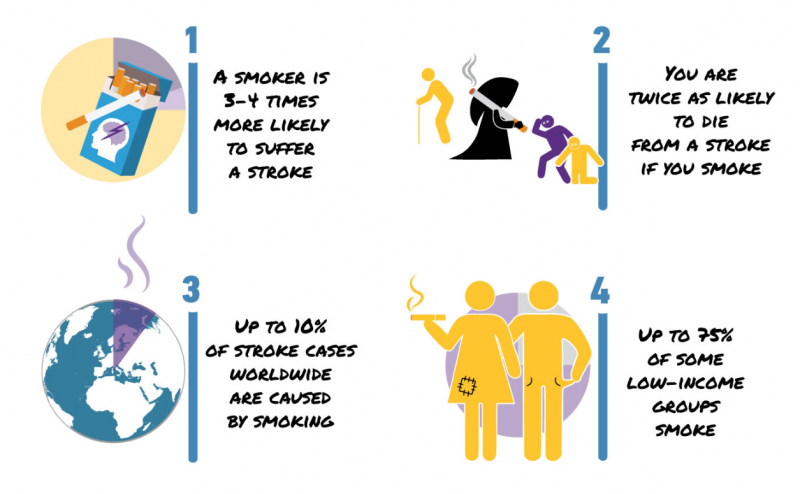
Jun 4, 2019
Each 31 May, the World No Tobacco Day is being celebrated around the globe by raising awareness about the harmful and deadly effects of smoking and the use of tobacco products. SAFE is trying to raise awareness about the dangers of smoking for another very important reason- Smoking is one of the modifiable stroke risk factors. Many studies suggest smoking almost doubles the risk of stroke and subarachnoid haemorrhage (SAH), a life-threatening type of stroke caused by bleeding into the space surrounding the brain (1). Long-term exposure to nicotine has many negative health effects. Some, such as a persistent cough, are noticeable. Whereas the hidden damage that happens within the brain is not often apparent until it’s too late. Research shows that the parts of a smoker’s brain that control everyday tasks, such as hand-to-eye coordination, are reduced in volume, which can impair its function (2).
According to the Statement given by EU Commissioner for Health and Food Safety, Vytenis Andriukaitis, on a global level, the figures are staggering – there are more than 7 million tobacco-associated deaths around the world each year. This is one of the main reasons why the EU and its Member States are active supporters of a global health treaty – the Framework Convention on Tobacco Control of the World Health Organisation.
“Tobacco consumption is the single largest avoidable health risk, and the most significant cause of premature death in the EU, responsible for nearly 700,000 deaths annually. This is not just a dry number. These are our family members, friends, colleagues. I am particularly concerned about young people taking up vaping and various new products like heated tobacco products and e-cigarettes, which are increasingly being marketed with misleading claims. 29% of young Europeans aged 15-24 are smoking. How many are using alternatives damaging their young lungs?” asked Mr Andriukaitis.
Up to 10% of stroke cases worldwide are caused by smoking
According to the World Health Organisation, smoking is thought to cause around 10% of cardiovascular disease worldwide. In 2008, the highest overall prevalence for smoking was estimated to be in the European Region, at nearly 29%. (3) Thankfully, in Europe, the death rate has fallen significantly over the last two years, but the number of people living with disabilities, as a result of stroke, continues to be a huge problem (4).
“The EU is working hard to protect citizens from the hazardous effects of tobacco use. One of our key milestone measures in the EU’s fight against illicit trade in tobacco products – the European systems of tobacco traceability and security features – became operational on 20 May. This means that consumers will soon see new traceability markings on the packs, together with the required security features. The traceability markings will enable national authorities to track and trace the movements of tobacco packs across the legal supply chain in the EU. In addition, security features will enable public authorities and citizens to determine if a tobacco product on the market is genuine or illicit” said Mr Andriukaitis in his official statement.
In conclusion, we all know smoking is bad for us. It’s been linked with all kinds of diseases, including stroke. But sometimes even the cold hard facts aren’t enough to make us want to kick the habit. If you’re considering cutting down or giving up, please visit SAFE’s website www.strokeprevention.info dedicated to education about stroke risk factors and check out five tips for quitting smoking.
References:
- James F. Meschia, MD et al. (2014). Guidelines for the Primary Prevention of Stroke. A statement for healthcare professionals from the American Heart Association/American Stroke Association. DOI: 10.1161/STR.0000000000000046. Stroke, 45: 3754-3832.
- Lim, T. S., Lee, J. S., Yoon, J. H., Moon, S. Y., Joo, I. S., Huh, K., & Hong, J. M. (2017). Cigarette smoking is an independent risk factor for post-stroke delirium. BMC neurology, 17(1), 56.
- Thun MJ, Apicella LF, Henley SJ. (2000). Smoking vs other risk factors as the cause of smoking-attributable deaths: confounding in the courtroom. JAMA, 284:706–712
- https://www.stroke.org.uk/sites/default/files/the_burden_of_stroke_in_europe_-_challenges_for_policy_makers.pdf
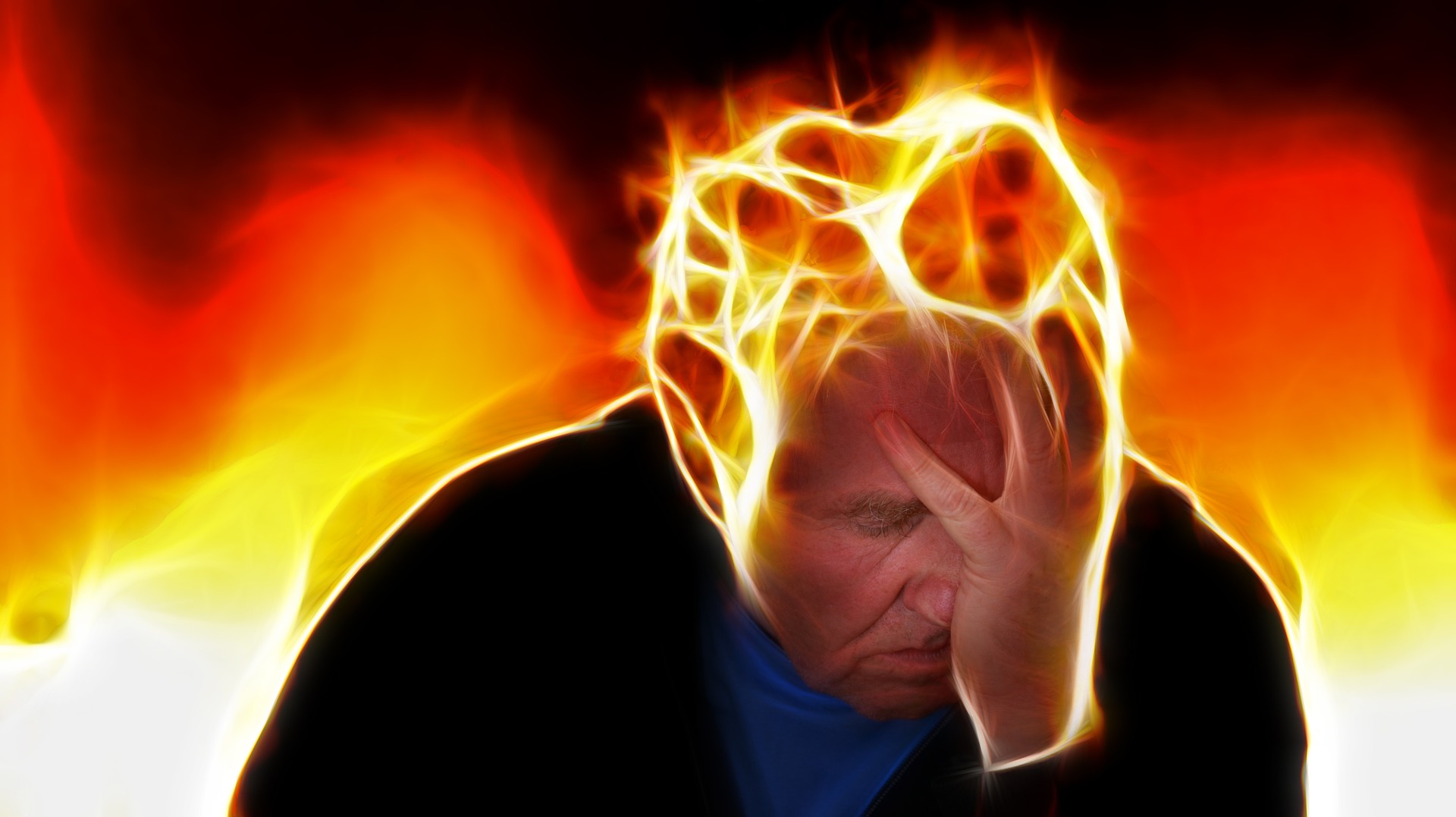
Jun 3, 2019
Written by Tom Balchin | First published on https://arni.uk.com
Stroke is one of many conditions that can lead to seizures, or epilepsy. You may think of these as ‘having fits’. In the UK this condition affects just under 1% of the population. Around 5% of people who have a stroke will have a seizure within the following few weeks. These are known as acute or onset seizures and normally happen within 24 hours of the stroke.
The good news is that your risk of having a seizure lessens with time following your stroke. But, you’ve really got to take care. I see people regularly who have fits for the first time. It’s never fun, but luckily, as someone who has had controlled epilepsy for over 20 years I know exactly how to identify these very early (it’s not that hard really). Quickly get the person to the floor, gently, into the recovery position and call for an ambulance. If you have a list of all their medications on hand to tell the paramedic, that would be ideal.
You are more likely to have had one if you have had a severe stroke, a haemorrhagic stroke or a stroke involving the part of the brain called the cerebral cortex. My own epilepsy came only after subarachnoid haemorrhage, (an uncommon, very serious and often fatal type of stroke caused by bleeding on the surface of the brain)
The causes of seizures are complex. Cells in the brain communicate with one another and with our muscles by passing electrical signals along nerve fibres. If you have epilepsy this electrical activity can become disordered and a sudden abnormal burst of electrical activity in the brain can lead to a seizure.
There are over 40 different types of seizures that can occur, but the most common ones are partial seizures or generalised seizures.
Partial or focal seizures only occurs in part of your brain. You may remain conscious and aware of your surroundings during a partial seizure (called a simple partial seizure) or you may become confused and unable to respond (a complex partial seizure). The symptoms you experience during a partial seizure will depend on which part of your brain has been affected. You may feel changes in sensation such as a tingling feeling, which spreads to other parts of your body.
Commonly people experience a rising feeling in their stomach (a bit like when you go over a humpback bridge). This is called an ‘epigastric rising sensation’. You may also experience uncontrollable stiffness, twitching or turning sensation in a part of the body such as your arm or hand, and/or disturbances in your vision, such as seeing flashing lights.
You can read the full article here.
Image credits: Pixabay.com
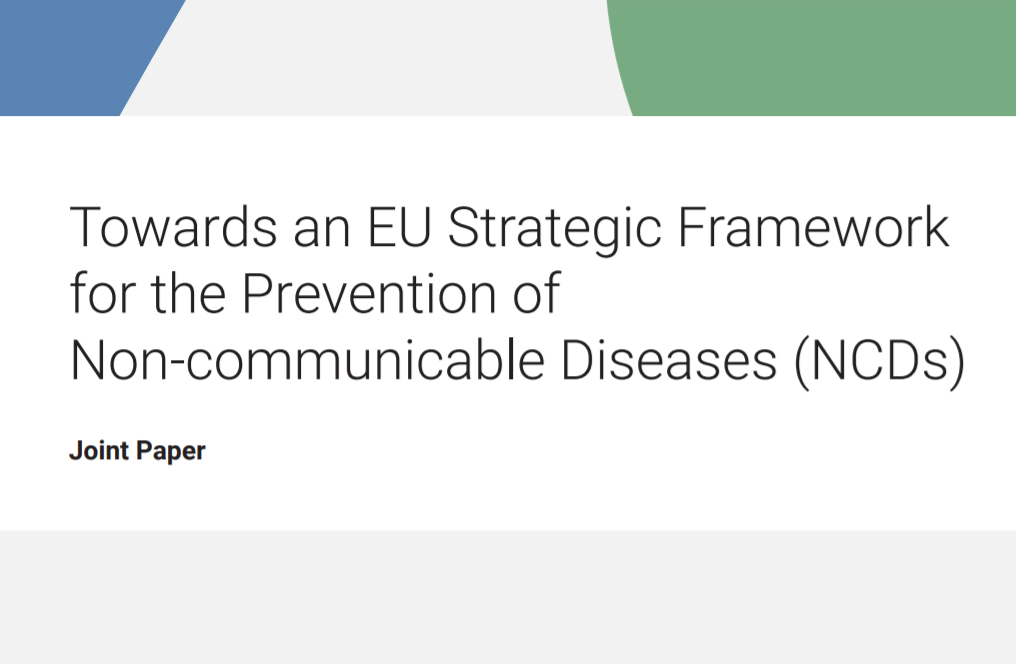
May 31, 2019
The European Chronic Disease Alliance (ECDA), the European Public Health Alliance (EPHA) and the NCD Alliance publish the paper “Towards an EU-Strategic Framework for the Prevention of Non-communicable Diseases” concluding that a new EU strategic framework to prevent non-communicable diseases (NCDs) is needed to address chronic diseases, the 21st century’s foremost health threat.
With 70% of respondents to a recent EU Barometer survey wanting to see more EU action on health and with epidemic levels of NCDs undermining people’s well-being, healthcare systems, and Europe’s economic and social prosperity, preventing NCDs should be a main priority for the next European Commission.
The mandate 2019-2024 is an opportunity to act upon commitments made at the UN High Level Meeting on NCDs in September 2018 and follow on the EU Reflection Process on Chronic Diseases to deliver concrete solutions to respond to the main common risk factors. While progress is made on reducing premature mortality from NCDs, longer lives do not necessarily translate into healthy lives.
With stroke being such an important topic among other non-communicable diseases, SAFE and ESO recently organised a panel discussion in the Committee of Regions in Brussels, under the Patronage of The Romanian Presidency, exploring the role of policy in tackling stroke. During the panel discussion, patient representatives and clinical experts called on the EU Institutions to recognize the burden of stroke as its own incredibly important entity, rather than diluting it in the wider classification of cardiovascular diseases. Panelists representing patients and clinicians also called for the EU to facilitate discussions between its Member States on the implementation of the Stroke Action Plan for Europe. As a next step to this meeting, SAFE and ESO begun a follow-up with speakers and participants to move forward with the identified opportunities. The immediate action that came as a result of this panel discussion was SAFE’s participation in the CHRODIS+ Conference, held in Budapest, Hungary on 15 May 2019. At this important meeting, SAFE was represented by Grethe Lunde, SAFE Board Member and a stroke survivor from Norway. SAFE actively participated in discussions on topics such as patient involvement, multi-morbidity, integrated care and employment.
Europeans spend between a quarter and a fifth of their lives in ill-health. 700 billion EUR is spent on treating NCDs in the EU each year – although many chronic diseases are to a considerable degree preventable. The paper proposes basic principles, priorities and actions for such an EU strategic framework, setting out a roadmap to make change happen. For more information, please contact: info@alliancechronicdiseases.org or epha@epha.org.
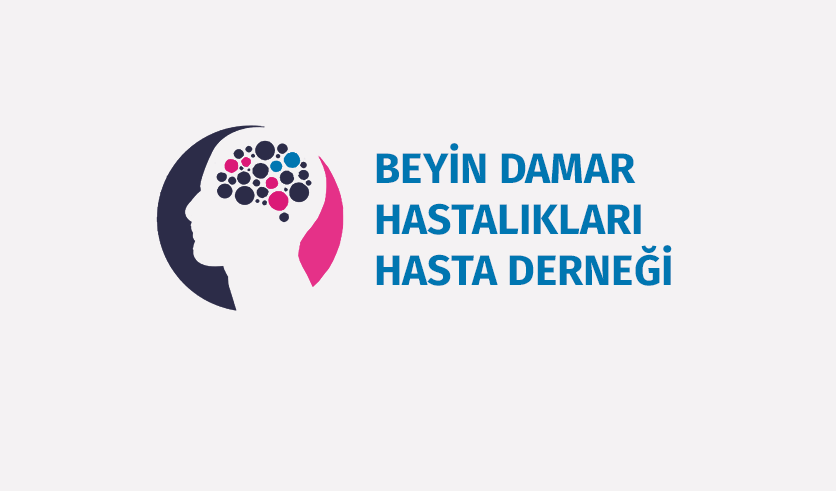
May 31, 2019
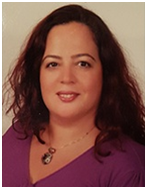 “In our country, our patients are facing several problems after stroke. The number of physical therapy units is adequate, however, we should pay extra attention for the subjects such as lack of training and methods, inadequate speech rehabilitation therapy, lack of environmental physical conditions for stroke cases, and often overlooked dementia and depression after stroke” said Füsun Mayda Domaç, Assoc. Prof, MD, Msc and Vice President of BEYINDER, Turkish Stroke Support Organisation.
“In our country, our patients are facing several problems after stroke. The number of physical therapy units is adequate, however, we should pay extra attention for the subjects such as lack of training and methods, inadequate speech rehabilitation therapy, lack of environmental physical conditions for stroke cases, and often overlooked dementia and depression after stroke” said Füsun Mayda Domaç, Assoc. Prof, MD, Msc and Vice President of BEYINDER, Turkish Stroke Support Organisation.
SAFE: What is one issue related to the life after stroke in your country that you think needs special attention?
FMD: One of the most noteworthy issues is the establishment of a number of rehabilitation centers by government incentives in Turkey. Although the physical facilities and numbers of the centers are adequate, the lack of physical therapists and physiotherapists, who are well equipped for neurorehabilitation and especially for stroke rehabilitation, is quite lacking. The number of physical therapy sessions that the Ministry of Health has provided free of charge in patients after stroke is insufficient. Although the physicians are willing to start treatment in patients in the early period, the number of free sessions and an inadequate number of equipped personnel negatively affect the success rates. In our country, physical factors create difficulties for the cases of stroke. It is extremely important to reintroduce stroke survivors to an active, disability-free life with an intensive rehabilitation program.
Other important issues we have come across in most stroke survivors are the isolation of social and work environment, fear of not recovering, and psychiatric problems such as depression and anxiety. Besides, vascular dementia can develop due to localization and severity of stroke. However, because we need to examine a large number of patients in a short time due to health policies in outpatient clinics, urgent and important complaints are considered at the forefront and psychiatric cognitive problems can be ignored. This situation complicates and delays clinical recovery in patients.
SAFE: What would be the solution, i.e. what is your organisation’s position regarding this issue?
FMD: The short duration of rehabilitation treatment and lack of adequate qualified personnel negatively affect the healing process even though the physical therapy centers are sufficient. In this context, in the neurorehabilitation, it will be helpful to prepare a training CD of physical therapy applications for stroke which explains practices in detail. In addition, neurology and physical therapy branches need to come together and exchange information on neurorehabilitation with joint meetings. Training sets can be prepared in cooperation with the Ministry of Health, and detailed brochures about hints and issues to be considered during physical therapy can be prepared and distributed. The Ministry of Health may be asked to supervise physical therapy centers in more detail and to support fully-equipped rehabilitation centers for stroke rehabilitation. The number of free service periods and sessions can be increased by discussing the necessity of having a long-term and intensive treatment protocol after stroke with the Ministry of Health. Beyinder works intensively on all these solutions.
Due to the health policies in our country, there is not enough time to examine stroke patients in the outpatient clinics. In addition, it is not easy to make detailed evaluations except for the basic complaints. In this respect, assessment forms for depression, anxiety, and cognitive problems can be prepared and asked to fill it with the help of a patient and/or their relatives before their visit and these forms can be evaluated guickly in the outpatient clinics. Assessment forms should be developed and implemented easy-to-read taking into account the health literacy of patients so that they can fill forms on their own. In order to raise awareness among neurologists, information brochures about post-stroke psychiatric and cognitive situations can be prepared and distributed.
SAFE: Please tell us more about your organisation.
FMD: Stroke patients are not alone anymore in Turkey. “BEYİNDER” which is Turkish cerebrovascular diseases patients’ society was established in August 2017 in Istanbul. BEYİNDER is a non-profit, national society for stroke patients, their families, caregivers and also for health professionals. Our aim is to provide help and support for all stroke patients in Turkey and provide public education by accurate information about cerebrovascular diseases.
Our society has a website (link: http://www.beyinder.org/). The web site of our society provides information about our society, understandable information about clinical signs and symptoms, primary and secondary prevention, therapy and rehabilitation of stroke for patients and care givers, information about communication and news about stroke in media. Our society also has several social media accounts including Facebook, Instagram and twitter in order to make people aware of the society and its website.
Official journal of the association began publishing in 2018 and the 4th issue is on the way. Editor of the journal is Prof. Uludüz. The journal provides general information on vascular health of brain for patients. We also send journal to hospitals in order to give patients and relatives at out-patient or in-patient clinics. The online version of our journal is also available on the website.
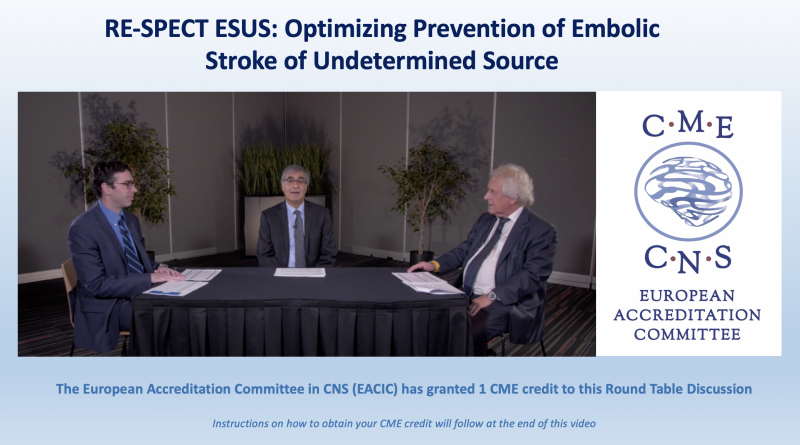
May 30, 2019
We would like to recommend to your attention a Round-Table discussion that held place at last year’s WSC in Montreal, Canada.
This Round Table Discussion reviews strategies for secondary prevention strategies in ESUS and the implications of the recent RE-SPECT ESUS results for clinical practice.
Following completion of this activity, learners will be able to:
- Describe RE-SPECT ESUS clinical trial results
- Outline the benefits and risks of NOACs in ESUS
- Discuss the implications of RE-SPECT ESUS for clinical practice
RE-SPECT ESUS: Optimizing Prevention of Embolic Stroke of Undetermined Source
Moderator:
Mike Sharma MD, MSc, Associate Professor, Division of Neurology, Department of Medicine, McMaster University, Ontario, Canada
Faculty:
Richard A. Bernstein MD, PhD, Professor of Neurology, Feinberg School of Medicine, Northwestern University, Illinois, USA
Hans-Christoph Diener MD, PhD, Professor of Neurology, University of Duisburg-Essen, Germany
Please click here to view video.
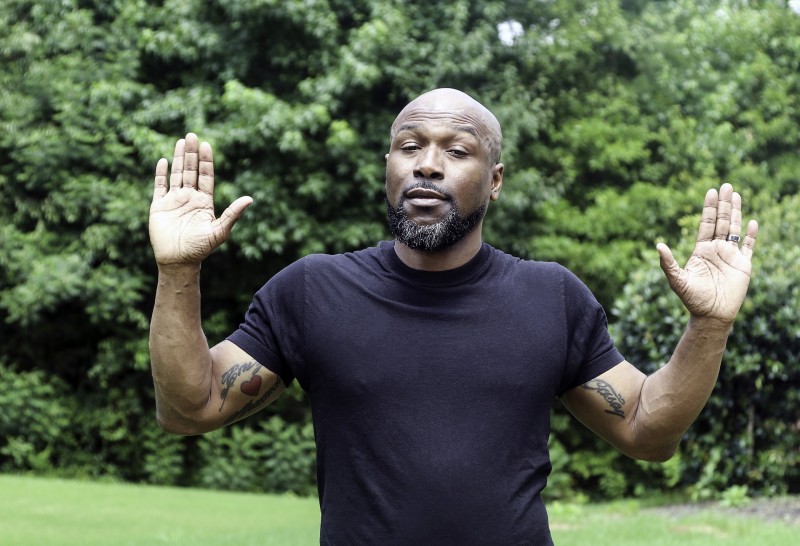
May 27, 2019
This article was first published on ScienceDaily.com
Although the occurrence of first-ever ischemic stroke (strokes due to a blood clot that blocks a blood vessel in the brain) at middle age has been decreasing over time, researchers have found that the decline is not as steep as seen in older adults.
The risk for stroke at midlife declined by approximately 39 percent, while risk of stroke at older age declined by 53 percent, when comparing a recent time period (1998-2005) to a previous time period (1962-67).
“Most strokes at midlife were due to diseases of the arteries (atherosclerosis) caused by a clot migrating from the heart. We also looked at vascular risk factors, such as hypertension and smoking, which have been declining among both age groups over time,” explained corresponding author Hugo J. Aparicio, MD, MPH, assistant professor of neurology at Boston University School of Medicine.
The researchers studied trends in the rate of ischemic stroke among two age groups in the Framingham Heart Study: middle age-35-55 years old and older age-above 55 years old. They estimated the rate of stroke occurring in four time periods, 1962-67, 1971-76, 1987-1991 and 1998-2005. They also looked at risk for stroke calculated using the Framingham Stroke Risk Profile, which gives an estimate for how likely a stroke will occur over the ensuing 10 years.
You can read the full article here.
Image source: Pixabay.com
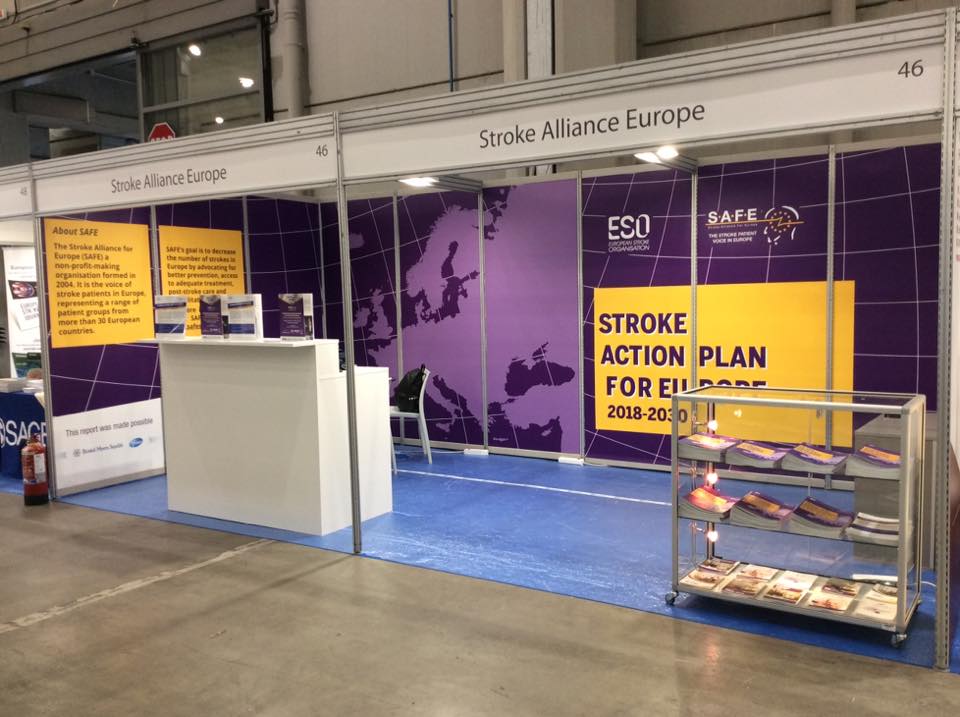
May 25, 2019
The 5th European Stroke Organisation Conference (ESOC), took place in Milan, Italy, from 22 to 24 May 2019.
ESOC 2019 was attended by more than 5,600 participants from all over the world. Stroke Alliance for Europe had a stand at this important event, providing information on the latest stroke advocacy activities.
One of the highlights of ESOC 2019 was the constitution of the Steering Committee for the “Stroke Action Plan for Europe 2018-2030” implementation, in which SAFE will take active participation, representing the voice of stroke patients from 33 European countries.
SAFE promoted the Stroke Action Plan on its stand, now available in additional seven European languages (French, Polish, Spanish, Portuguese, Russian, Ukrainian and Greek) with many more translations to come. The Stroke Action Plan’s translation will increase its reach throughout Europe and significantly help stroke support organisations in with their further advocacy work.
Two of the SAFE Board members, Anita Arsovska from North Macedonia and Hariklia Proios from Greece held important lectures as part of ESOC Scientific Programme. SAFE’s President, Jon Barrick, co-chaired a session on the last days of the congress, covering the topic of the burden of stroke in Europe and the Life After Stroke issues.
Apart from the Board members, other SAFE organisations’ members from Turkey, Italy, Croatia, Hungary, Portugal and many other countries took active part in the ESOC 2019 programme within their fields of expertise.
Video credits: Turkish Stroke Support Organisation BEYINDER.
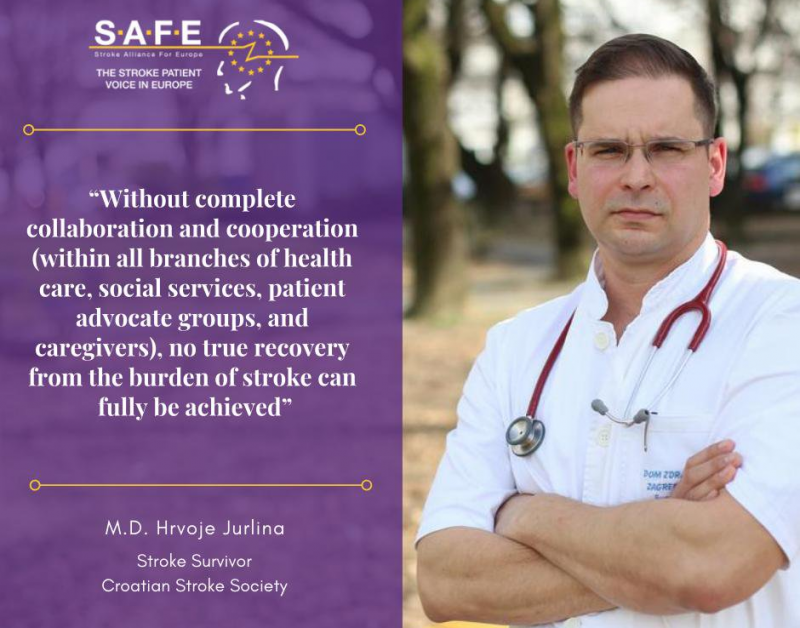
May 24, 2019
“For stroke survivors the real battle begins after they have been discharged from the hospital. The bio-psycho-social burden on any society (family unit), if they are not properly prepared or organized, can very quickly become devastating” said Hrvoje Jurlina, M.D., stroke survivor from Croatian Stroke Society.
SAFE: What is one issue related to the life after stroke in your country that you think needs special attention?
HJ: As in every country the healthcare system has its flaws. The root to a great percentage of these imperfections within the healthcare system lies in the lack of logistical coordination within the system itself. For example: ”If a bus driver does not know his own bus root how can anyone on board the bus be expected to arrive successfully to their desired destination?” (The Bus symbolizes Stroke, the bus driver represents the healthcare system, the bus route substitute as ‘Life after Stroke’, the bus stops depict the specific levels of care, therapy, and rehabilitation the stroke survivor must go through, and the desired destination of the stroke survivor within that bus route represents the desired level of recovery from the burden of stroke.) This is very much so the situation in many healthcare systems in regards to stroke patients. Once the stroke survivor is released from the hospital , the stroke survivor and their primary caregiver (”get on that bus”) are given very little if any information regarding post hospital recovery procedures and care options. The information given is most often very superficial and lacks a realistic picture of what awaits the stroke survivor and their primary caregiver in the immediate and distant future.
SAFE: What would be the solution, i.e. what is your organisation’s position regarding this issue?
HJ: The need for some form of standardized criteria regarding recovery, care options as well as an insight into patient rights for stroke survivors and their primary caregivers is thoroughly needed. ‘ The bus route must be laid out, all of the bus stops must be clearly marked so that the stroke survivor as well as their primary caregiver may successfully navigate and reach their desired destination, which is the recovery from the burden of stroke. To achieve these goals a firm foundation must be put in place in which an alliance of all parties involved in the stroke survivors rehabilitation and recovery can come together in order to maximize a successful post stroke outcome. Without complete collaboration and cooperation (within all branches of health care, social services, patient advocate groups, and the stroke survivors primary caregiver) no true recovery from the burden of stroke can fully be achieved. This continuous burden not only inhibits all aspects of the stroke survivors life but directly influences the lives of their family members and society as a whole.
SAFE: Please tell us more about your organisation.
HJ: Croatian Stroke Society (Hrvatsko društvo za prevenciju moždanog udara) was founded in 1997 with the aim to prevent stroke among persons at risk and stroke survivors, and to improve diagnostics, treatment and rehabilitation, based on the latest scientific knowledge. Raising the stroke awareness in Croatia, which will lead to the reduction of stroke by creating a healthier and more conscious society, is our vision. The Croatian Stroke Society is divided into two branches which are collaborating – stroke survivors section and professional/scientific section. Our activities are focused at educating the population, stroke survivors, caregivers and the medical staff about stroke to improve diagnosis, treatment and rehabilitation. The stroke survivors section members are primarily involved on raising the stoke awareness among the population including stroke survivors and their family and caregivers organizing public campaigns, patient groups, lectures with stroke risk assessments, activities on social media channels, etc. The professional/scientific section members are primarily involved on raising the stroke awareness and education of health professionals as well as providing the medical scientific background to the public and stroke survivors. Croatian Stroke Society is proud member of the Stroke Alliance for Europe, European Stroke Organization and Central and Eastern European Stroke Society.

May 20, 2019
This article was first published on ScienceDaily.com
A new study from the University of Eastern Finland shows that a moderately high intake of dietary cholesterol or consumption of up to one egg per day is not associated with an elevated risk of stroke. Furthermore, no association was found in carriers of the APOE4 phenotype, which affects cholesterol metabolism and is remarkably common among the Finnish population. The findings were published in the American Journal of Clinical Nutrition.
Findings from earlier studies addressing the association of dietary cholesterol or egg intake with the risk of stroke have been contradictory. Some studies have found an association between high dietary cholesterol intake and an increased risk of stroke, while others have associated the consumption of eggs, which are high in cholesterol, with a reduced risk of stroke. For most people, dietary cholesterol plays a very small role in affecting their serum cholesterol levels. However, in carriers of the apolipoprotein E phenotype 4 — which significantly impacts cholesterol metabolism — the effect of dietary cholesterol on serum cholesterol levels is greater. In Finland, the prevalence of APOE4, which is a hereditary variant, is exceptionally high, with approximately one third of the population presenting as carriers. Yet, research data on the association between a high intake of dietary cholesterol and the risk of stroke in this population group has not been available until now.
The dietary habits of 1,950 men aged between 42 and 60 years with no baseline diagnosis of a cardiovascular disease were assessed at the onset the Kuopio Ischaemic Heart Disease Risk Factor Study, KIHD, in 1984-1989 at the University of Eastern Finland. APOE phenotype data were available for 1,015 of the men participating in the study. Of those, 32% were known carriers of APOE4.
During a follow-up of 21 years, 217 men were diagnosed with stroke. The study found that neither dietary cholesterol nor egg consumption was associated with the risk of stroke — not even in carriers of APOE4.
The findings suggest that moderate cholesterol intake or daily egg consumption are not associated with the risk of stroke, even in persons who are genetically predisposed to a greater effect of dietary cholesterol on serum cholesterol levels. In the highest control group, the study participants had an average daily dietary cholesterol intake of 520 mg and they consumed an average of one egg per day, which means that the findings cannot be generalised beyond these levels. One egg contains approximately 200 mg of cholesterol. In this study, about a fourth of the total dietary cholesterol consumed came from eggs. Furthermore, the generalisability of this study is also weakened by the fact that the study population did not have a pre-existing cardiovascular disease at baseline and the size of the study population was relatively small. Therefore, the findings of the study should be verified in a larger cohort as well as in people with a pre-existing cardiovascular disease, who are currently advised to limit their intake of cholesterol and eggs.
Story Source: University of Eastern Finland. “Dietary cholesterol or egg consumption do not increase the risk of stroke, Finnish study finds.” ScienceDaily. ScienceDaily, 20 May 2019. <www.sciencedaily.com/releases/2019/05/190520093448.htm>.






 “In our country, our patients are facing several problems after stroke. The number of physical therapy units is adequate, however, we should pay extra attention for the subjects such as lack of training and methods, inadequate speech rehabilitation therapy, lack of environmental physical conditions for stroke cases, and often overlooked dementia and depression after stroke” said Füsun Mayda Domaç, Assoc. Prof, MD, Msc and Vice President of BEYINDER, Turkish Stroke Support Organisation.
“In our country, our patients are facing several problems after stroke. The number of physical therapy units is adequate, however, we should pay extra attention for the subjects such as lack of training and methods, inadequate speech rehabilitation therapy, lack of environmental physical conditions for stroke cases, and often overlooked dementia and depression after stroke” said Füsun Mayda Domaç, Assoc. Prof, MD, Msc and Vice President of BEYINDER, Turkish Stroke Support Organisation.







